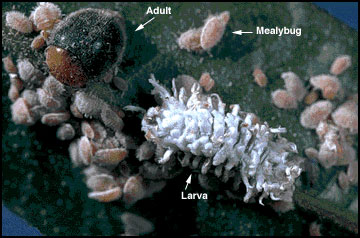 |
||||
Back to Predators Table of Contents
Cryptolaemus montrouzieri This beetle was imported into the United States in 1891 from Australia by one of the early biological control pioneers, Albert Koebele, to control citrus mealybug in California. Although C. montrouzieri initially devastated the citrus mealybug populations in citrus groves, it was unable to survive the winter except in coastal areas.  Top: Mealybug destroyer adult and larva attacking citrus mealybugs. Courtesy University of California Statewide IPM Project. Photo: Jack Kelly Clark
Appearance Cryptolaemus montrouzieri is a small (about 3-4 mm long), dark brown lady beetle with a tan to orange head and posterior. The larvae grow up to 1.3 cm in length and have woolly appendages of wax (their true legs are barely visible underneath) which makes them resemble mealybugs, although they are about twice as large as the adult female citrus mealybug. C. montrouzieri eggs are yellow.
Citrus groves in the coastal areas of California, interiorscapes, and greenhouses. In addition, C. montrouzieri is released seasonally into inland citrus orchards.
Pests Attacked (Host Range) C. montrouzieri attacks citrus and closely related mealybugs and some soft scales, including hemispherical scale and its relatives. It is considered an important predator of citrus and long-tailed mealybug in greenhouses and interior plantscapes and is being introduced in a biocontrol program in the West Indies to control pink hibiscus mealybug.
Life Cycle Adult females lay eggs among the cottony egg sack of adult female mealybugs. Eggs hatch into larvae in about 5 days at 27°C (80°F). The three larval stages last from 12-17 days during which the larvae feed on mealybug eggs, young crawlers, and the honeydew produced by mealybugs.
C. montrouzieri pupates in sheltered places on stems or on greenhouse structures. Adults emerge after 7-10 days and live four months. Four days after emerging, adult females begin to lay eggs, and the lifetime total may be as many as 400. Adults may live up to 2 months.
Relative Effectiveness C. montrouzieri is a voracious feeder of mealybug in both the larval and adult stages - a single larva may consume up to 250 small mealybugs. They are most effective when mealybug populations are high, and repeated releases may be necessary if mealybug populations are low. They require cottony egg masses for egg-laying (long-tailed mealybugs do not have cottony egg masses). Although adults and young larvae prefer to feed on mealybug eggs, older larvae will attack any mealybug stage. Adults can fly and cover large areas to search for food. If mealybugs are scarce, they will fly off in search of other related insects, e.g. aphids and soft scales, although reproduction is substantially greater on mealybugs. Because C. montrouzieri cannot survive cold winters, they must be reintroduced into orchards where mealybugs were a problem the previous year in the early spring . The exception is moderate coastal regions. Like other ladybeetles, C. montrouzieri tends to disperse when released. In indoor sites, keep windows and vents closed the day of release. Recent studies have shown that adults and larvae will spend more time searching a leaf for mealybugs if it has honeydew than if honeydew is absent. Although mealybug destroyers will not persist after the mealybug population has been controlled in small greenhouse areas, in more complex interior areas where there are multiple infestation sites and alternate prey, they do perist. In Indianapolis, a single release of 100 beetles has persisted for over 5 years. If birds exist in interiorscapes, however, they will feed on adult beetles.
Conservation It is important to remember that C. montrouzieri superficially resembles its prey, the mealybug. This can cause problems if large numbers of larvae are present on crops that are ready to be shipped or in indoor situations (such as malls) where the public may be unaware of the benefits of natural enemies. For general information about conservation of natural enemies, see Conservation in the Tutorial section on this site, Feature Article on conservation in Volume II, No. 1 of Midwest Biological Control News.
Pesticide Susceptibility Little is known.
Commercial Availability Readily available from commercial suppliers (see the off-site publication, Suppliers of Beneficial Organisms in North America).
Adapted from: Sadof, Cliff (1995) Know Your Friends: Mealybug Destroyer, Midwest Biological Control News Online, II:5. and Applied Bio Pest (1997) Lifecycle of Cryptolaemus montrouzieri, Oxnard, CA 93035. Photograph from Raupp, M.J., Van Driesche, R.G., and Davidson, J.A. (1993) Biological Control of Insect and Mite Pests of Woody Landscape Plants: Concepts, Agents and Methods. University of Maryland, College Park, MD. 39 pp. For information contact: Agricultural Duplicating Service, 6200 Sheridan Street, Riverdale, MD, 20737. Tel: 301-403-4264.
Back to Predators Table of Contents
|
|
|||